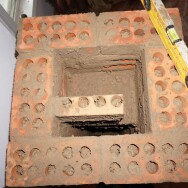Some reflections on materials
Posted by admin on Nov 29, 2012 in Blog | 5 comments

Obviously we are making our heaters with completely different design criterias than what we would do back home. We recieved some questions about this. And here I want to clarify why we are doing this, and why you should consider mabe not to do the same thing in your place.
There are different conciderations that make us to do things differently here than back home, to point out some:
- Different general expectations to qualities of products. (If a heater here lasts 20 years it is 20 times better than the local heaters that burn hole in them through one heating season)
- The desire to make things available for everyone. Economy is bad, and making a heater that costs 10 000 azn is never going to help anyone
- Reproducable. We work only with what can be found localy, we dont want to make ourselves a bottle neck by implementing feks. Imported Cast Iron that only we know how to get.
- We want things to be safe, but regulations for fireplaces here are not enforced/existent, so we can to a larger degree use comon sence and do what make sence in different cases.
- Implementation of local knowledge. We like to honor the local culture by implementing good ideas from their own inherited knowledge. In this way our products makes more sence
- Usage of local made products provides work instead of competing with local products.
Some examples:
Local made doors: These doors will last mabe 5-10 years. Cast-Iron lasts mabe 100. But the Cast Iron is unavailable and we would have to import it ourselves.By making a local cheap product (5 azn) we provide work to the people that are currently making the stoves that everyone are using. And we avoid becoming the bottle-neck in implementing the technology localy. If you can get beautifull Cast Iron doors and can afford it. Thats what I would do at home !!
Bricks with holes: These are localy made bricks, they are not perfectly shaped and they have holes in them that nead to be filled.This can be done if you can fill them with the same type of mud that the bricks are made from. If not there will be difference in expanding and you will have airpockets inside that will effect the heaters performance and may lead to cracking. There is no reason to do this if you can get solid bricks made for stovebuilding where you live!
Burnchamber liner made of wool-clay mix: This is a local tradition that is used for making the local Tendir bread ovens. It is proven to work well through centuries of traditions. It is fun to adapt this to our heaters and see that it is very crack resistant and pleasing to work with. It makes the fire burn really hot because wool dosent loose its insulative value when it is soked ! Proof is in the pudding, this is a great idea. But it lasts only some years and then you might nead to do repairs. Offcource a burn chamber made of firebrick (chamote) is stronger, but it is also 20 times more expensive, and less carbon neutral.












Hi
I am curious about the wool-clay mixture. We don’t have any money to make an oven but do need to spend next winter a “little” warmer than the previous ones (it was only 15 degrees Celsius in the house). I happen to have 7 bags of wool which I would like to use both for insulation but maybe also for building a stove. Could you please explain? Also, do you have any ideas of making a chimney?
With friendly greetings,
Saskia Steinhorst
Fryslân, The Netherlands
Hi !
It seams like you face some of the same issues that we do trying to make things as cheap as possible My first question is if there is any good clay-soil near you. (Shake the mud in a jar with water and see if it wont settle for a long time) If you have sticky clay mud. Then you can build a great heater with just a few bricks for the burn chamber. I would also recomend you to take a look at the rock bucket heater I tested earlyer, it is a feasable solution if you can get an old barrel. If you have a massonry stove a simple old iron pipe can be used safely for taking the smoke out, because it burns clean with a low smoke temperature and it doesnt nead more than 15cm diameter. This does demand that the operator uses the stove properly to be safe. (no wet wood, not smoldering burns, check it for soot buildups etc). But there are regulations for such things in Europe… The wool is specially for reinforcing the clay when you build.
My first question is if there is any good clay-soil near you. (Shake the mud in a jar with water and see if it wont settle for a long time) If you have sticky clay mud. Then you can build a great heater with just a few bricks for the burn chamber. I would also recomend you to take a look at the rock bucket heater I tested earlyer, it is a feasable solution if you can get an old barrel. If you have a massonry stove a simple old iron pipe can be used safely for taking the smoke out, because it burns clean with a low smoke temperature and it doesnt nead more than 15cm diameter. This does demand that the operator uses the stove properly to be safe. (no wet wood, not smoldering burns, check it for soot buildups etc). But there are regulations for such things in Europe… The wool is specially for reinforcing the clay when you build.
So sorry for not responding sooner, we got side tracked

Yes, we need to do things as cheap as possible, or actually with things we can find, not buy. Situation is pretty desperate.
We do have clay soil but unfortunately it is polluted by the last owner. Oil, chemicals, etc. Not good for heating up and then having inside the home with children. However, we do have lots of free red bricks, as well as a couple of hundred lime-sandstone bricks we took out of the building. These bricks are made from calcium oxide (quicklime) and sand (ratio 92:7 with water) and then formed by pressure and steam. We also have chamotte brick, or heat resistant bricks.
What we would love is a kitchen mass stove that also retains heat during the day. Your model looks great but we would need to find a way to fabricate the cook top and the door. However, I do have a very small old iron stove which we might use parts of, i.e. the cook top with 3 cooking rings (they consist of several rings which cause the cook spot to become larger as you take more rings out).
I did look at your rock bucket and left a comment there as well. I guess you haven’t seen it yet
Could we discuss some more options? You sound like you have a lot of hands-on experience!
Kind regards, Saskia
Using items from an old castiron stove is an exellent and sheap solution. Using the doors demands some work, but the cooctop is easy to use. You can weld a door from normal iron, it want bend much because it get cooled down by the air that comes in there. But the coocktop is much better if it is castiron. This stove can be used. It is free from ekonmka in Sweden where I did a workshop. It will heat well as well as good for coocking.
Sorry, I don’t seem to be able to spell my own name correctly :-\ Please find the CORRECT email address above.
Kind regards, Saskia